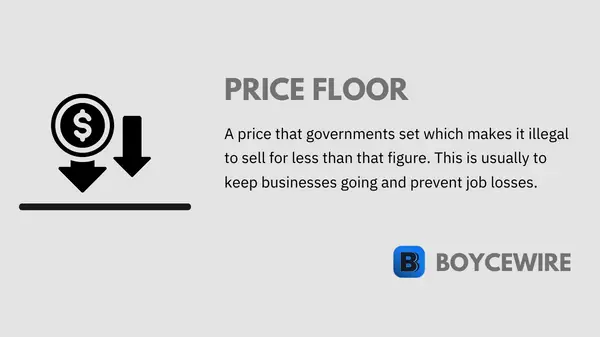Price Floor: Definition, Examples & Effects

What is a Price Floor?
Price floors are most effective when they are set above the equilibrium point where supply and demand meet. If the price floor is set below the equilibrium, it will have no effect since firms can sell at a higher price than the minimum price set.
On the other hand, if the price floor is set too high, it may result in an economic surplus where more goods are supplied than demanded. For example, setting a price floor of $800 for an iPhone may benefit Apple by allowing them to sell at a higher price, but it may also result in fewer customers purchasing the product, leading to lower overall profits.
Key Points
- A price floor is a minimum price that the government sets on a good or service.
- Private groups may also implement price floors, for instance, the NFL imposed a floor on the resale value of tickets – although it has now stopped doing so.
- In economics, a price floor is most effective when is it placed above the equilibrium point as this would force prices to increase from the existing equilibrium to the desire price.
Price floors are most effective when they are set above the equilibrium point whereby supply and demand meets. This is because if the price floor is set below the equilibrium, then the price floor is set below the market value. In other words, the firm is able to sell at a higher price than the minimum price set. For example, the iPhone sells for around $699. Yet if the price floor was set at $500 (below the equilibrium), it would have no effect.
If the price floor was set at $800 instead, it would benefit Apple as it would be selling at a higher price. However, fewer customers will purchase the iPhone as a result – meaning the actual profit it receives may in fact be lower. This results in an economic surplus, whereby more goods are supplied than demanded.

As the price is higher than it would be in a free market, this incentivizes greater production. However, demand falls, creating a surplus of goods. Governments may counteract this by purchasing the remaining surplus. For instance, the European Union’s Common Agricultural Policy (CAP) sets a price floor on agricultural products to guarantee farmers an income. Even if production doubles or triples, the EU will purchase the surplus.
Effects of a Price Floor
1. Black Market
When prices are artificially set above the market value, it can lead to the creation of black markets as producers seek to sell their surplus production. An example of this is the NFL’s former price floor, which set a minimum price on resold tickets. This made it more difficult for season ticket holders and other resellers to sell, as the price was higher than what many buyers were willing to pay. As a result, a black market was created to allow those who wanted to sell tickets to find buyers at a lower price.
2. Higher Prices
Price floors set above the equilibrium point can result in higher prices for consumers. For example, if doughnuts sell for $2 each and the price floor is set at $2.50, customers would have to pay an extra 50 cents per doughnut. While the baker may potentially benefit from the higher prices, the customer does not, which is why price floors are often viewed as a form of corporate welfare.
3. Lower Demand
When a price floor is set above the market equilibrium, customers may turn to substitute goods instead. For example, if a price floor for a loaf of bread raises its price from $1.50 to $2, consumers may choose to switch to buying cereal, which costs $2 for a box.
4. Over-Production
When prices are set above the equilibrium, suppliers may produce more than the demand requires. The graph below demonstrates that when the price floor is above the equilibrium, suppliers are willing to supply more, but the higher prices result in reduced demand. This creates a surplus in the market.
Governments may choose to purchase any excess production resulting from a price floor in order to support struggling firms. However, as demonstrated by the EU’s Common Agricultural Policy (CAP), this practice can create an incentive for overproduction as farmers are guaranteed a market for their output regardless of demand.

5. Price Support
Governments may choose to purchase any surplus production resulting from a price floor, in order to support businesses that may be negatively impacted by the higher prices. These businesses may actually lose customers and become worse off, despite the higher prices. By stabilizing the market and securing these businesses, the government seeks to mitigate any negative effects of the price floor.
Price Floor Examples
1. Alcohol
In 2018, Scotland set a price floor on alcoholic beverages, becoming the first country in the world to do so. The minimum price was set at 50 pence (70 cents) per unit of alcohol, which targeted cheap but strong alcoholic beverages. The goal was to decrease the consumption of cheap, highly toxic alcoholic drinks and minimize the side effects. For example, alcohol misuse is estimated to cost Scotland £3.6 billion ($4.9 billion US) annually, covering healthcare, policing, public disorder, and criminal damage.
Typically, price floors aim to increase income for producers on the supply side. However, in this instance, it is intended to limit demand-side consumption.
2. EU Common Agricultural Policy (CAP)
The Common Agricultural Policy (CAP) was introduced in Europe under the Treaty of Rome in 1957. Its main objective was to create stability in the agriculture markets, where farmers were often affected by fluctuations in supply due to weather conditions such as droughts. The policy aims to support the prices of goods such as wheat, rice, beef, butter, and dairy products by setting a price floor. This means that if the farmers cannot sell their products at the market price, the European government will purchase them, acting as a safety net.
3. Minimum Wage
The minimum wage is a widespread price floor around the world, with nearly every country having one. However, its impact varies depending on the country and the level at which it is set. Some countries set it above the equilibrium level, resulting in lower demand for workers, while others set it below and have little effect.
Setting the price floor of labor above the equilibrium point can also have other outcomes. It may lead to higher levels of employment despite the higher cost, which may be subsidized by existing benefits such as pension contributions, bonuses, and overtime pay. Although the usual supply and demand mechanism may not apply, the cost may still be incurred in a different way.
4. Imports
In 2016, India implemented a price floor on steel imports as a measure to discourage foreign competition, particularly from China, from flooding the market with cheap steel.
The domestic steel manufacturers were under significant pressure as customers were opting for the cheaper Chinese steel, posing a threat to the survival of the Indian manufacturers. To protect its domestic steel industry, the government artificially inflated the price of Chinese steel, making it uncompetitive, and essentially protected its own industry. This resulted in a return of demand for Indian steel, as it became comparatively cheaper.
Price Ceiling vs Price Floor
A price floor is where a minimum price is set for a good or service. In other words, suppliers cannot sell below that price. It is usually determined by the government, but public entities such as the NFL have been known to organize a private price floor. This is generally to protect the income and survival of the producer.
By contrast, a price ceiling is a maximum price set for a good or service. Examples include rent controls and pay caps. These aim at reducing prices to the consumer and restricting inequality.
The main differences can be summarised below:
- A price floor sets minimum price, whilst price ceiling sets a maximum price.
- Price floors aim to protect producers, whilst price ceilings look to protect consumers.
- Price ceilings can lead to shortages, reduced quality of goods and services, whilst price floors can result in surpluses, and inefficient allocation of resources.
Price Floor Pros & Cons
Pros
- Support for producers.
- Improved working conditions.
Cons
- Can create surpluses.
- Inefficient allocation of resources.
- Can create Unemployment.
Price Ceiling Pros & Cons
Pros
- Increased affordability.
- Prevention of price gouging.
Cons
- Can create Shortages.
- Reduced quality.
- Can create Black markets.
Related Topics
FAQs
A price floor is a minimum price a consumer must pay for a good or service. It is usually mandated by government in order to protect businesses or provide a disincentive to consume that good.
The minimum wage is a classic example of a price floor. It sets employers a minimum, or floor, by which they are legally allowed to pay an employee. If this is set above the prevailing market rate, it may in fact lead to unemployment. However, if it is below the market rate and equilibrium point, then it may improve the lives of those who were previously paid under this amount.
Price floors that are set in extreme access of the equilibrium point are bad for society. This is because it creates an artificial surplus and creates a reduction in demand that is not socially optimal.
Price floors are implemented with the intention of protecting producers and the jobs that they create. Without price floors, goods may become too cheap for businesses to continue production, therefore resulting in job losses. This may also result in a loss of competition, which may in the long term harm consumers if it leads to a monopoly like structure.
A price floor is set above the equilibrium price, which is the price at which the quantity supplied equals the quantity demanded. When a price floor is implemented, sellers cannot sell below the set price, effectively creating a lower limit on the market price. If the price floor is set above the equilibrium price, a surplus may occur, where the quantity supplied exceeds the quantity demanded.
About Paul
Paul Boyce is an economics editor with over 10 years experience in the industry. Currently working as a consultant within the financial services sector, Paul is the CEO and chief editor of BoyceWire. He has written publications for FEE, the Mises Institute, and many others.

Further Reading
 Are Cryptocurrencies Worth the Risk? An Objective Analysis - Table of Contents What is Cryptocurrency What is Cryptocurrency Mining Types of Cryptocurrency How to Buy Cryptocurrency Advantages and Disadvantages…
Are Cryptocurrencies Worth the Risk? An Objective Analysis - Table of Contents What is Cryptocurrency What is Cryptocurrency Mining Types of Cryptocurrency How to Buy Cryptocurrency Advantages and Disadvantages…  Debt to Equity Ratio - The debt-to-equity ratio is a financial metric that compares a company's total debt to its total equity to assess its…
Debt to Equity Ratio - The debt-to-equity ratio is a financial metric that compares a company's total debt to its total equity to assess its…  Pareto Principle: Definition, Pros, Cons & Examples - The Pareto Principle is the idea that 20% of causes lead to 80% of effects. In other words, a minority…
Pareto Principle: Definition, Pros, Cons & Examples - The Pareto Principle is the idea that 20% of causes lead to 80% of effects. In other words, a minority… 